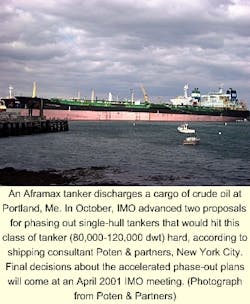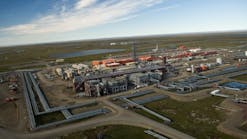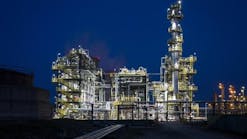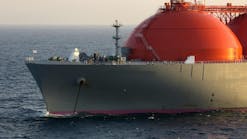An Aframax tanker discharges a cargo of crude oil at Portland, Me. In October, IMO advanced two proposals for phasing out single-hull tankers that would hit this class of tanker (80,000-120,000 dwt) hard, according to shipping consultant Poten & partners, New York City. Final decisions about the accelerated phase-out plans will come at an April 2001 IMO meeting. (Photograph from Poten & Partners)
Aframax and Panamax oil tankers will be hit hard by phase-out timetables proposed for single-hull tankers by the International Maritime Organization.
The effect will be even more drastic than on the industry's workhorse, the very large crude carrier (VLCC).
Shipping-industry consultant Poten & Partners, New York City, published these conclusions about the potential effects of the new proposals from mid-October to early November (OGJ, Nov. 20, 2000, p. 68).
VLCCs include vessels of greater than 200,000 dwt; Aframax, 80,000-120,000 dwt; and Panamax 50,000-80,000 dwt.
The consultant's evaluation said that the number of Aframax tankers to be phased out more quickly under the IMO proposals than under existing MARPOL regulations would be nearly 90 vessels in 2008 and about 120 vessels in 2014.
For the smaller-sized Panamax tanker fleet, Poten & Partners said the results would be "even more draconian" with an early phase out of more than 110 vessels in both 2009 and 2010.
IMO proposals
The 45th session of IMO's Marine Environment Protection Committee (MEPC 45) approved in October a set of proposed amendments to MARPOL 73/78. That is the International Convention for the Prevention of Pollution from Ships (1973), amended by a subsequent Protocol in 1978.
MARPOL 73/78 has its own phase-out schedule that has come under pressure to be accelerated since the Erika, a Maltese-registered tanker, sank nearly a year ago off the northwestern coast of France and spilled as much as 18,000 tonnes of heavy fuel oil (OGJ, Dec. 20, 1999, p. 38).
IMO said that approval of the proposed amendments by MEPC 45 paves the way for adoption of a revised Regulation 13G of MARPOL at MEPC 46 when it meets in April 2001.
Timetable
As of early November, Poten & Partners estimated the size of the Aframax tanker fleet at 581 vessels; the size of the Panamax tanker fleet was 341, excluding US flag tankers that are being phased out under the Oil Pollution Act of 1990. (A few pre-1975 built vessels have also been excluded.)
Of the world's fleet, 274 Aframax tankers (47%) and 89 Panamax vessels (26%) are double hull and excluded from phase out. The 38 Aframax and 24 Panamax tankers that do not have segregated ballast tanks (SBT) are phased out under existing MARPOL regulations.
Thus, tankers vulnerable to the accelerated phase-out timetable of the recent MEPC 45 proposals are single-hull tankers with SBT:
- 269 Aframax tankers (46% of the fleet).
- 228 Panamax tankers (67% of the fleet).
The consultant compared the cumulative number of tankers to be phased out by a given year for existing MARPOL regulations (MARPOL 73/78) with the cumulative number to be phased out under Alternatives A and B. "This provides a good indication of the accelerated nature of the proposed alternatives versus MARPOL regulations," said the company in its published analysis last month.
Phase out under existing MARPOL regulations occurs during the indicated year (Tables 1 and 2), while phase out for the two proposed alternatives occurs by Jan. 1 of the indicated year, actually hastening the average phase out by 6 months, said Poten & Partners.
While there is a major difference between the proposals in years 2012-2016 when Alternative A outpaces Alternative B's phase-out schedule, the real acceleration in phase out begins after 2003.
Tables 1 and 2 illustrate the number of Aframax and Panamax tankers to be phased out for the existing and proposed IMO schedules (Alternative A). They show the difference in the cumulative number of vessels between existing rules and the proposed Alternative A.
As seen, a considerable number of single-hull Aframax and Panamax tankers with SBT will be phased out.





